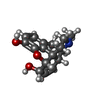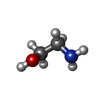+Search query
-Structure paper
| Title | Molecular recognition of morphine and fentanyl by the human μ-opioid receptor. |
|---|---|
| Journal, issue, pages | Cell, Vol. 185, Issue 23, Page 4361-4375.e19, Year 2022 |
| Publish date | Nov 10, 2022 |
 Authors Authors | Youwen Zhuang / Yue Wang / Bingqing He / Xinheng He / X Edward Zhou / Shimeng Guo / Qidi Rao / Jiaqi Yang / Jinyu Liu / Qingtong Zhou / Xiaoxi Wang / Mingliang Liu / Weiyi Liu / Xiangrui Jiang / Dehua Yang / Hualiang Jiang / Jingshan Shen / Karsten Melcher / Hong Chen / Yi Jiang / Xi Cheng / Ming-Wei Wang / Xin Xie / H Eric Xu /   |
| PubMed Abstract | Morphine and fentanyl are among the most used opioid drugs that confer analgesia and unwanted side effects through both G protein and arrestin signaling pathways of μ-opioid receptor (μOR). Here, ...Morphine and fentanyl are among the most used opioid drugs that confer analgesia and unwanted side effects through both G protein and arrestin signaling pathways of μ-opioid receptor (μOR). Here, we report structures of the human μOR-G protein complexes bound to morphine and fentanyl, which uncover key differences in how they bind the receptor. We also report structures of μOR bound to TRV130, PZM21, and SR17018, which reveal preferential interactions of these agonists with TM3 side of the ligand-binding pocket rather than TM6/7 side. In contrast, morphine and fentanyl form dual interactions with both TM3 and TM6/7 regions. Mutations at the TM6/7 interface abolish arrestin recruitment of μOR promoted by morphine and fentanyl. Ligands designed to reduce TM6/7 interactions display preferential G protein signaling. Our results provide crucial insights into fentanyl recognition and signaling of μOR, which may facilitate rational design of next-generation analgesics. |
 External links External links |  Cell / Cell /  PubMed:36368306 PubMed:36368306 |
| Methods | EM (single particle) |
| Resolution | 2.8 - 3.3 Å |
| Structure data | EMDB-28066, PDB-8ef5: EMDB-28069, PDB-8ef6: EMDB-28077, PDB-8efb: EMDB-28085, PDB-8efl: EMDB-28086, PDB-8efo: EMDB-28088, PDB-8efq: |
| Chemicals |  ChemComp-7V7:  ChemComp-CLR:  ChemComp-MOI:  ChemComp-WH2:  ChemComp-WH9:  ChemComp-8QY:  ChemComp-ETA: |
| Source |
|
 Keywords Keywords |  SIGNALING PROTEIN / SIGNALING PROTEIN /  mu-opioid receptor / mu-opioid receptor /  G protein / G protein /  fentanyl / fentanyl /  morphine / morphine /  oliceridine oliceridine |
 Movie
Movie Controller
Controller Structure viewers
Structure viewers About Yorodumi Papers
About Yorodumi Papers

















